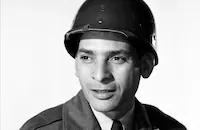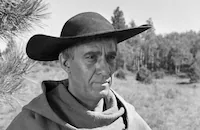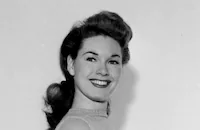Second Chance

Brief Synopsis
Cast & Crew
Rudy Maté
Robert Mitchum
Linda Darnell
Jack Palance
Sandro Giglio
Rodolfo Hoyos Jr.
Film Details
Technical Specs

Synopsis
As soon as he checks into a hotel in Porto Olieno, Mexico, New York bookkeeper Edward Dawson is accosted in his room by thug Cappy Gordon. Although Dawson denies Cappy's charges that he has betrayed their boss, gangster Vic Spalato, who is under investigation by the U.S. Senate, Cappy shoots the bookkeeper in cold blood. The next day, in San Cristóbal, Spalato's former girl friend, singer Clare Sinclair, reads about Dawson's murder in the newspaper and panics. While arranging to leave town, Clare, who now goes by the name Sheppard, spots Cappy in her hotel lobby and flees in a cab, eventually ending up at a bullfight arena. There, as American boxer Russ Lambert prepares to fight his Mexican challenger Rivera, Clare seeks out her boss, bar owner Felipe. Desperate for cash, Clare sells Felipe a valuable pair of earrings, then watches as Russ, whose career in the States crumbled after he accidentally killed an opponent, wins the match. Just then, Clare sees Cappy among the spectators and hurries out of the arena. Doggedly, Cappy follows Clare through the streets and into a telegraph office, stopping Clare from sending a telegram to the Senate committee, stating that she will testify against Spalato. After Cappy declares his love and offers to spare her life if she runs off with him, Clare bolts from the office and heads for Felipe's bar. By threatening to expose Felipe to Cappy, Clare convinces Felipe to persuade Russ to meet her at the secluded Posado de Don Pascual. There, Clare encourages Russ's romantic interest, but does not tell him about Cappy or Spalato. When Russ suggests they take the funicular to La Cumbre, an isolated, mountaintop village, Clare eagerly agrees. In La Cumbre, the couple enjoy a quiet drink and stroll through the marketplace, unaware that Cappy, who forced Felipe to tell him Clare's whereabouts, is nearby. They then watch a provocative dance, performed by a young man and woman, whose older husband Vasco drags her off in a jealous fury. Upset by the sight, Clare and Russ head toward the hotel where they will be spending the night, and in the moonlight, Russ kisses Clare. After Russ reveals that he is aware of her relationship with Spalato, Clare confesses that she is attracted to him but is not free of her past. The next morning, at the hotel, a newly confident Russ announces that he is resuming his career in the States right after he boxes his next match. Russ persuades Clare to accompany him, but his phone call to his manager, Charlie Malloy, is overheard by Cappy, who then confronts Clare. Afraid that Cappy will shoot Russ, Clare agrees to go with Cappy, on condition he leave Russ alone. Later, Russ discovers that Clare has checked out and dashes to the funicular, jumping aboard just as it is departing with Clare and Cappy, as well as Vasco, who has been arrested by policeman Hernandez for killing his wife the night before. Still unaware of Cappy's mission, Russ questions Clare about her change of heart, but she refuses to tell him why she is abandoning him. Halfway down the mountain, Cappy tries to accost Clare on the car's parapet, but Russ comes to her rescue, and Cappy is disarmed. After Clare finally tells Russ the truth about Cappy, Russ and Cappy start to fight, causing the car to sway dangerously. One of the cables pulling the car then snaps, completely disabling the funicular. With no other means of rescue, Vasco volunteers to try to swing on a spare cable to the nearest cliffside and climb down for help. Vasco's attempt fails, however, and he plummets to his death. Russ tries next and succeeds, but after he goes, one of the other passengers, Englishman Mr. Woburn, declares that only six people will fit in the rescue car, and the disabled car's cable will not last long enough for a second run. After three men are chosen to stay behind, including Woburn and the conductor, Cappy grabs Hernandez' gun, shooting him in the process, and announces that he and Clare are the only two who are going. Just then, Russ returns with the rescue car and jumps Cappy. The two men fight on top of the disabled car, and Russ finally sends Cappy hurtling to his death. Moments before the cable gives way, a second car arrives, and all the passengers, including an embracing Clare and Russ, are rescued.

Director
Rudy Maté
Cast

Robert Mitchum

Linda Darnell

Jack Palance

Sandro Giglio
Rodolfo Hoyos Jr.
Reginald Sheffield
Margaret Brewster

Roy Roberts
Salvador Báguez

Maurice Jara
Judy Walsh
Dan Seymour

Fortunio Bonanova

Milburn Stone
Abel Fernández
Michael Tolan
Richard Vera

Martin Garralaga
Virginia Linden

Shirley Patterson
Tony Martinez
Eddie Gomez
Tina Menard
Orlando Beltran
Judy Landon
Marc Wilder
Joe Dominguez
Pete Rand
Oresta Seragnoli
Ricardo Alba
Dan Bernaducci
Bob Castro
John Cliff
Henry Escalante
Joe Herrera
Eddie Le Baron
David Morales
George Navarro
Manuel Paris
Tony Roux
Max Sagner
Luis Alvares
Eddie Kervant
Crew
C. Bakaleinikoff
Mel Berns
Sydney Boehm
Cliff Broughton
John Burch
Carroll Clark
Albert S. D'agostino
Robert Ford
Larry Germain
Stuart Gilmore
Keogh Gleason
James Gooch
Edmund Grainger
Howard Hughes
D. M. Marshman Jr.
Frank Mcwhorter
Oscar Millard
Clem Portman
Lloyd Richards
Darrell Silvera
William Snyder
Carlos Villatoro
Ralph Volkie
Roy Webb
Sam Wiesenthal
Michael Woulfe

Photo Collections
Film Details
Technical Specs

Articles
Second Chance
Hughes also hoped to take advantage of Darnell's impressive figure by shooting her in 3D. The beautiful star had always fascinated the tycoon. According to legend, he even had offered to buy her from one of her husbands, cinematographer Peverell Marley. They had dated off and on, so when Darnell left her original home studio, 20th Century-Fox, Hughes tried to put her into films at his own RKO. Darnell had put on weight since leaving Fox, however, and refused to wear the form-fitting gowns Hughes had picked for her. Instead, the glamorous star spent most of the film in a conservative suit.
When Mitchum got his first look at the script, he was convinced that 3D was the picture's only selling point. In fact, he complained so much about the nonsensical plot the studio brought in another writer to punch it up -- former newspaperman Sydney Boehm, who would score a hit that year with The Big Heat. The studio also had to contend with re-write demands from the Mexican government, who would not allow them to film on location unless they deleted references to the Latin women as "tamales" and Mitchum's line "Latin American men beat their women once a week regularly, and if they did not the women would miss the beatings."
Shooting in Mexico hardly proved an advantage. After weeks of shooting in Taxco, the company only had a few overhead shots of Mitchum and Darnell racing through the city's streets. An open-air boxing sequence shot in Cuernavaca produced other problems. The set was so hot that Mitchum, who had experience as a boxer, had trouble looking like the match's winner. He kept sagging from the heat. And the local extras looked into the camera so much director Rudolph Mate eventually had to re-shoot the entire thing when the company returned to Hollywood.
At least the Mexican shoot produced the kind of bad publicity that Mitchum's fans doted on. The studio had arranged for Mitchum and Palance to participate in a charity event to raise money for the Mexican chapter of Boys Town. Mitchum's on-stage appearance to present them with a $5,000 donation was marred by some rowdy American students. When one of the students got in the star's face, Mitchum decked him. The PR people rushed both actors to a nearby nightclub, where another fight broke out -- this time with a drunken general who had gotten a little too familiar with Palance. When gunshots broke out, Mitchum got his and Palance's wives out to the limos, while Palance covered him by throwing a table at the shooters.
Mitchum and Palance got into a fight of their own once they were back in Hollywood. During their climactic battle on the doomed cable car Palance, who liked to psych himself up before his scenes, got carried away with the action and hit Mitchum in the head. The star retaliated by delivering a hard punch to Palance's stomach, and the screen villain promptly puked all over the star.
With so much chaos and mismanagement, Second Chance naturally wound up a success. Not only did it do well at the box office -- Mitchum always credited his fans, or as he called them, "the great unwashed" -- but it won respectable reviews, particularly for the final suspense sequence. The only major complaints were about the 3D process, with which critics and audiences were already tiring. Nonetheless, it was not one of Mitchum's favorite experiences (feelings he had no trouble sharing with gossip columnist Hedda Hopper, much to the studio executives' dismay). It would prove to be the last film he made at RKO. One previously completed picture would be released later, and he would finish out his ten-year contract with the studio with loan-outs before turning down a supporting role in Cattle Queen of Montana (1954).
Producer: Sam Wiesenthal
Director: Rudolph Mate
Screenplay: Oscar Millard, Sydney Boehm, D.M. Marshman, Jr.
Based on a story by Marshman
Cinematography: William E. Snyder
Art Direction: Albert S. D'Agostino, Carroll Clark
Music: Roy Webb
Principal Cast: Robert Mitchum (Russ Lambert), Linda Darnell (Clare Shepard), Jack Palance (Cappy Gordon), Sandro Giglio (Cable Car Conductor), Rodolfo Hoyos, Jr. (Vasco), Reginald Sheffield (Mr. Woburn), Margaret Brewster (Mrs. Woburn), Roy Roberts (Charley Malloy), Dan Seymour (Felipe), Fortunio Bonanova (Hotel Manager), Milburn Stone (Edward Dawson).
BW-83m. Closed captioning.
by Frank Miller

Second Chance
Quotes
Which do you suppose came first, the hotel or all this atmosphere?- Russ
Who needs music?- Russ
Spilato is something we used to step on in Chicago when it came crawling out of the woodwork.- Russ
He'll manage to get another gun in San Cristobal.- Clare
Who's going to wheel him to the store to buy it?- Russ
Trivia
Notes
According to an April 1951 Hollywood Reporter news item, the story of Second Chance was inspired by an actual, recent event in Rio de Janeiro, in which a cable car spanning the bay broke down and was suspended with fourteen passengers for ten hours. A November 1951 Hollywood Reporter news item announced that Susan Hayward would star in the picture. Both Robert Mitchum and Jack Palance were former professional boxers. Abel Fernandez, who plays "Rivera," was a real-life boxer in Mexico and made his screen debut in the film. Although a Hollywood Reporter news item lists the Los Amigos Trio in the cast, their appearance in the final film has not been confirmed. Most of the film was shot in Mexico, including Taxco, near Mexico City, according to Hollywood Reporter news items. Modern sources list Cuernavaca as an additional location. Second Chance marked RKO's first 3-D picture, and its first stereophonic release. According to a September 1953 Variety article, the film did well at the box-office, despite the high cost of the 3-D, stereophonic prints and the limited number of theaters equipped for 3-D projection. The film also was released in standard 2-D.















